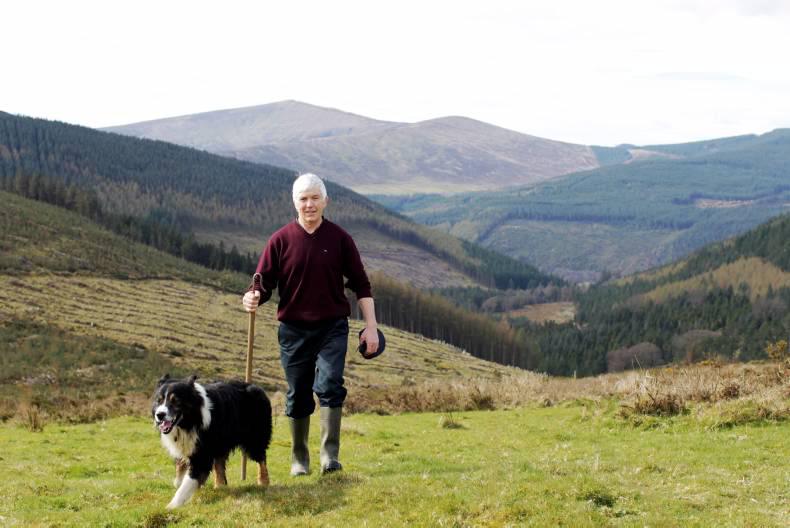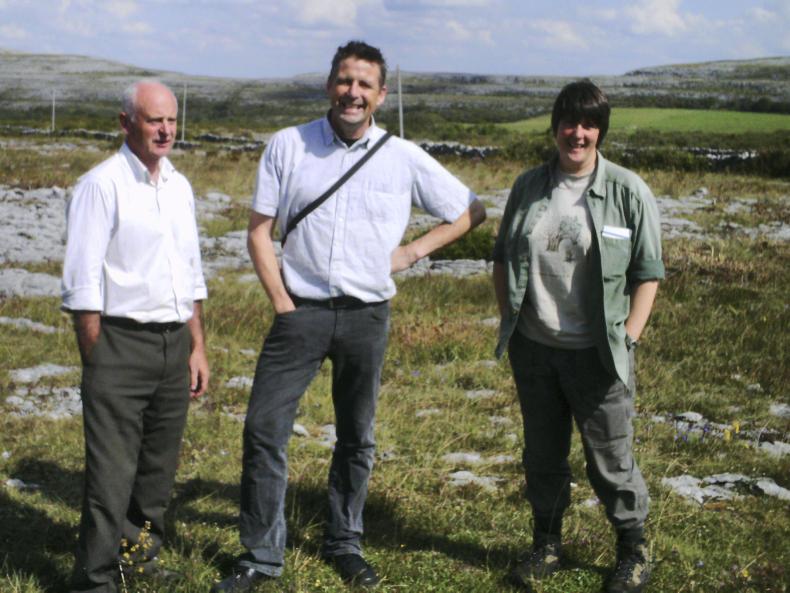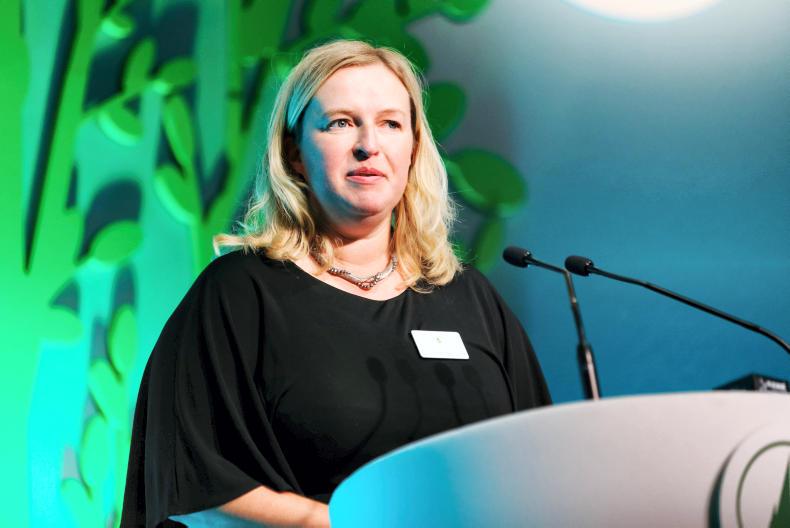Grazing sheep in the Wicklow uplands is not just about producing kilos of meat, it maintains the landscape that tourists visit the garden county to see. By controlling the scrub through the practices of burning and grazing it maintains a fodder supply for deer too, which stops them from invading the lowlands.
However, due to a number of economic and social factors, farming in the uplands is no longer as extensive as it once was and some traditions are dying out. This not only presents concerns for habitats and the environment, but also agri-tourism. The Wicklow Uplands Council (WUC) visited the Burren LIFE programme in Co Clare to model a new locally led agri-environmental scheme on it for the farmers in the Wicklow mountains.
“The key driver is to get young people back farming on the hills,” said Pat Dunne, chair of the IFA national hill committee. “It’s been shown time and time again that the most cost-effective way to maintain the hills is to keep the farmers farming there. If the hills were kept in good condition, that’s what the tourists want to see when they come out. If it was left to keep going the way it is going; in 30 years’ time it will be a jungle.”
Following their visit to the Burren, they got a LEADER grant for a study to be carried out to focus on identifying the best management of upland habitats in Co Wicklow. Prepared by Mary Tubridy and the WUC, the report concluded a need for a Sustainable Uplands Agri-Environmental Scheme (SUAS) and a change in the permitted dates for controlled burning of vegetation and the establishment of controlled burning groups.
SUAS
The scheme’s specifications include payments linked to the quality of biodiversity and the achievement of specific management tasks. What is put forward is an improved integrated vegetation management system including controlled burning, swiping, grazing and other practical vegetation management methods to ensure a productive and sustainable upland pastoral economy while improving the biodiversity of upland habitats.
The report was received well by the Minister for Agriculture Simon Coveney under the last government, when it was presented to him at Glendalough in 2013. The WUC maintains that the presentation led to the ringfencing of funds under the Rural Development Programme specifically for locally led agri-environmental schemes.
“Up until then, nobody had thought of bringing it outside of the Burren – that sowed the seed to apply it outside the Burren,” Dunne said.
Given the timeframe that the Department gave to the WUC, it will be early 2018 before applications to SUAS could open. According to Dunne, the Department of Agriculture is obliged to provide funding to hen harrier farmers through the same pool. This puts SUAS fourth on the list of importance after the Burren, hen harriers and pearl muscles.
“The payments will have to give a realistic return on work. You can’t expect a young person who wants to rear a family to run a farm that’s not viable,” said Dunne.
Locally led
Members of the WUC agree that while problems in their area are similar to those in other areas, such as the Blackstairs mountains, the nature of locally led schemes means that you can’t apply their project elsewhere.
“You don’t do a one size fits all,” said Dunne.
“It has to be tailored to the individual area. And the people in the area are the best ones to understand it.”
Each area in the country has their own specific species of wildlife and the WUC did some work on creating an inventory of species as part of their research that created SUAS.
While the WUC has a number of staff already employed for its current functions, the implementation of this scheme would create the need to employ another person. This adds further value to local areas in terms of helping the economy in rural Ireland.
“Along with the employment, if you could encourage a few young farmers to stay farming on the hills, there’s employment as well,” said Dunne, who points out that works completed under the scheme would most likely mean more people would be employed to help out with burning and clearing scrub.
What has led to the degeneration of the Wicklow mountains?
Change in burning dates in 2000.Decoupling.Ageing population.Celtic Tiger.Suckler and sheep farmer, Peter Murphy (pictured above), started out in his career working for Coillte. He said that skills older farmers possess are constantly being undermined. A scheme such as SUAS would help farmers like him.
“The sheep would be on the mountain most of the time, except for lambing,” said Murphy. “I worked in Coillte when I left school and they often had a 10- or 12-day extension to burn even from the deadline in the middle of April if you had a bad year like this year. They’d even burn a patch for an adjoining farmer.”
Murphy was familiar with the practice of controlled burning 30 years ago. Having uncontrolled vegetation is dangerous because it creates the threat of having uncontrolled, accidental fires that cause a lot of damage.
“That time, the fire would be kept between patches. There’d be one or two patches burnt every year. It wouldn’t be let grow as far as it does now.”
Not only do young farmers not know how to burn vegetation now, but they also haven’t got sheep that will stay in their own area on a commonage.
“The problem with these commonages now is to try and get sheep to settle back on them,” said Murphy. “The ewes won’t stay where they’re supposed to.”
He says the trick is to train the ewe lamb from the beginning and go up on the hill once or twice a week to shepherd them back to where they should be.
Farmers in the Wicklow mountains have also found that mountain breeds, such as the Wicklow Cheviot, will stay up higher on the hill without needing boundaries to keep them there.
Grazing sheep in the Wicklow uplands is not just about producing kilos of meat, it maintains the landscape that tourists visit the garden county to see. By controlling the scrub through the practices of burning and grazing it maintains a fodder supply for deer too, which stops them from invading the lowlands.
However, due to a number of economic and social factors, farming in the uplands is no longer as extensive as it once was and some traditions are dying out. This not only presents concerns for habitats and the environment, but also agri-tourism. The Wicklow Uplands Council (WUC) visited the Burren LIFE programme in Co Clare to model a new locally led agri-environmental scheme on it for the farmers in the Wicklow mountains.
“The key driver is to get young people back farming on the hills,” said Pat Dunne, chair of the IFA national hill committee. “It’s been shown time and time again that the most cost-effective way to maintain the hills is to keep the farmers farming there. If the hills were kept in good condition, that’s what the tourists want to see when they come out. If it was left to keep going the way it is going; in 30 years’ time it will be a jungle.”
Following their visit to the Burren, they got a LEADER grant for a study to be carried out to focus on identifying the best management of upland habitats in Co Wicklow. Prepared by Mary Tubridy and the WUC, the report concluded a need for a Sustainable Uplands Agri-Environmental Scheme (SUAS) and a change in the permitted dates for controlled burning of vegetation and the establishment of controlled burning groups.
SUAS
The scheme’s specifications include payments linked to the quality of biodiversity and the achievement of specific management tasks. What is put forward is an improved integrated vegetation management system including controlled burning, swiping, grazing and other practical vegetation management methods to ensure a productive and sustainable upland pastoral economy while improving the biodiversity of upland habitats.
The report was received well by the Minister for Agriculture Simon Coveney under the last government, when it was presented to him at Glendalough in 2013. The WUC maintains that the presentation led to the ringfencing of funds under the Rural Development Programme specifically for locally led agri-environmental schemes.
“Up until then, nobody had thought of bringing it outside of the Burren – that sowed the seed to apply it outside the Burren,” Dunne said.
Given the timeframe that the Department gave to the WUC, it will be early 2018 before applications to SUAS could open. According to Dunne, the Department of Agriculture is obliged to provide funding to hen harrier farmers through the same pool. This puts SUAS fourth on the list of importance after the Burren, hen harriers and pearl muscles.
“The payments will have to give a realistic return on work. You can’t expect a young person who wants to rear a family to run a farm that’s not viable,” said Dunne.
Locally led
Members of the WUC agree that while problems in their area are similar to those in other areas, such as the Blackstairs mountains, the nature of locally led schemes means that you can’t apply their project elsewhere.
“You don’t do a one size fits all,” said Dunne.
“It has to be tailored to the individual area. And the people in the area are the best ones to understand it.”
Each area in the country has their own specific species of wildlife and the WUC did some work on creating an inventory of species as part of their research that created SUAS.
While the WUC has a number of staff already employed for its current functions, the implementation of this scheme would create the need to employ another person. This adds further value to local areas in terms of helping the economy in rural Ireland.
“Along with the employment, if you could encourage a few young farmers to stay farming on the hills, there’s employment as well,” said Dunne, who points out that works completed under the scheme would most likely mean more people would be employed to help out with burning and clearing scrub.
What has led to the degeneration of the Wicklow mountains?
Change in burning dates in 2000.Decoupling.Ageing population.Celtic Tiger.Suckler and sheep farmer, Peter Murphy (pictured above), started out in his career working for Coillte. He said that skills older farmers possess are constantly being undermined. A scheme such as SUAS would help farmers like him.
“The sheep would be on the mountain most of the time, except for lambing,” said Murphy. “I worked in Coillte when I left school and they often had a 10- or 12-day extension to burn even from the deadline in the middle of April if you had a bad year like this year. They’d even burn a patch for an adjoining farmer.”
Murphy was familiar with the practice of controlled burning 30 years ago. Having uncontrolled vegetation is dangerous because it creates the threat of having uncontrolled, accidental fires that cause a lot of damage.
“That time, the fire would be kept between patches. There’d be one or two patches burnt every year. It wouldn’t be let grow as far as it does now.”
Not only do young farmers not know how to burn vegetation now, but they also haven’t got sheep that will stay in their own area on a commonage.
“The problem with these commonages now is to try and get sheep to settle back on them,” said Murphy. “The ewes won’t stay where they’re supposed to.”
He says the trick is to train the ewe lamb from the beginning and go up on the hill once or twice a week to shepherd them back to where they should be.
Farmers in the Wicklow mountains have also found that mountain breeds, such as the Wicklow Cheviot, will stay up higher on the hill without needing boundaries to keep them there.









SHARING OPTIONS